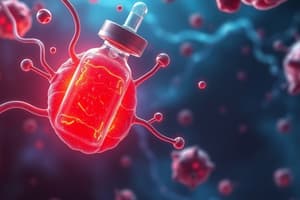Podcast
Questions and Answers
What is a common symptom of Type 1 diabetes?
What is a common symptom of Type 1 diabetes?
- Mildly elevated glucose levels
- Polyuria (correct)
- Asymptomatic presentation
- Obesity
Which condition is associated with Type 2 diabetes presentation?
Which condition is associated with Type 2 diabetes presentation?
- Long-term complications without prior symptoms (correct)
- Glucosuria and ketonuria
- Severe weight loss
- Immediate insulin treatment
What symptom might both Type 1 and Type 2 diabetes patients experience?
What symptom might both Type 1 and Type 2 diabetes patients experience?
- Immediate need for insulin treatment
- Increased thirst (polydipsia) (correct)
- Blurred vision due to osmotic changes
- Dehydration caused polyphagia
Which statement is true regarding the blood glucose levels in Type 1 diabetes?
Which statement is true regarding the blood glucose levels in Type 1 diabetes?
What is a diagnostic criterion for Type 2 diabetes?
What is a diagnostic criterion for Type 2 diabetes?
Flashcards are hidden until you start studying
Study Notes
Clinical Picture of Diabetes
Type 1 Diabetes
- Characterized by classic symptoms: polyuria (increased urination), polydipsia (increased thirst due to dehydration), polyphagia (increased hunger), and unexplained weight loss.
- Patients may experience blurred vision owing to osmotic changes affecting the eye.
- Common infections include oral and genital candidiasis.
- Blood glucose levels are significantly elevated, confirming the diagnosis.
- Immediate insulin treatment is critical to manage the condition.
- Presence of glucosuria (glucose in urine) and ketonuria (ketones in urine) is common.
Type 2 Diabetes
- Often asymptomatic for extended periods; may reveal complications before diagnosis.
- Frequently associated with obesity; other symptoms include thirst, polyuria, and various infections (skin, oral, genital, urinary tract).
- Glucose levels may only be slightly elevated.
- Diagnosis relies on specific tests: fasting blood glucose levels and glucose levels measured 2 hours after a 75 g oral glucose tolerance test.
Studying That Suits You
Use AI to generate personalized quizzes and flashcards to suit your learning preferences.




